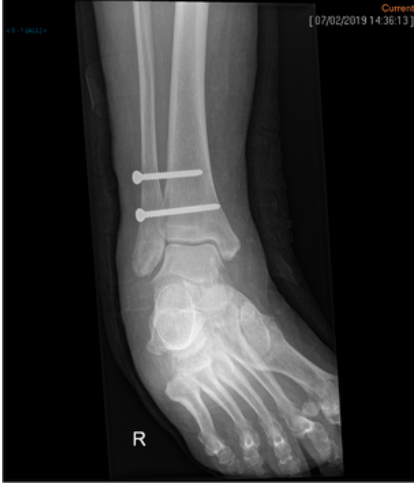Syndesmosis Injury Surgery
Syndesmosis Injury Surgery Information Sheet
What is Syndesmosis Injury Surgery?
Syndesmosis injury surgery is a procedure performed to stabilise and repair a serious ligament injury in the ankle. The syndesmosis is a group of ligaments that connect the two lower leg bones—the tibia (shinbone) and the fibula—just above the ankle joint. This connection helps stabilise the ankle and allows for proper foot and leg movement. When severely damaged, surgical repair by an experienced Orthopaedic Surgeon in Adelaide may be necessary to restore stability and prevent long-term complications.
Syndesmosis injuries, sometimes called “high ankle sprains”, happen when these ligaments are stretched or torn, usually from twisting or forceful impact. These injuries may cause ongoing pain, ankle instability, and difficulty walking or bearing weight. Surgery is recommended to restore stability and function.
The surgery typically involves repositioning the bones of the lower leg and securing them with surgical devices such as screws, buttons, or tightrope systems. These hold the bones in place while the ligament heals. The aim is to restore normal alignment and prevent long-term complications like arthritis or chronic instability.
Who is Suitable for Syndesmosis Injury Surgery?
Most syndesmosis injuries benefit from surgery. Surgery is recommended for people who have:
- Damage to the main part of the ligament: If the strongest part of the ligament is damaged, or the bones are misaligned.
- Unstable Ankle Joint: If the ankle feels loose or unstable when walking or bearing weight.
- Associated Fractures: If the injury includes broken bones and ligament damage.
- Active Lifestyles or Sporting Goals: Athletes or active individuals who require strong ankle stability to return to their sport or physical activities.
Benefits of Syndesmosis Injury Surgery
Surgery can provide several benefits for the right patient. These include:
- Restoring Ankle Stability: Reduces the feeling of the ankle giving way or feeling weak.
- Reducing Long-Term Pain: Helps prevent ongoing pain caused by joint instability.
- Improving Mobility and Function: Allows you to walk, run, and perform activities more comfortably.
- Preventing Arthritis: Surgery can reduce the risk of developing arthritis later in life by restoring proper joint alignment.
- Returning to Sport or Work: Helps active individuals return to their previous activity level.
- Addressing Associated Fractures: Allows proper management if bone fractures are involved.
Types of Syndesmosis Injury Surgery
Several surgical techniques are used to treat syndesmosis injuries. The choice depends on the nature of the injury, the patient’s activity level, and the surgeon’s preference.
- Screw Fixation Surgery
- How It Works: Metal screws are placed through the fibula and tibia to hold the bones in proper alignment while the ligament heals.
- Considerations: Screws may need to be removed after healing to restore full ankle movement, but sometimes they are left in place if they do not cause issues.
- Suture-Button (Tightrope) Fixation Surgery
- How It Works: Special surgical devices called suture buttons or tightropes secure the bones. These devices are flexible and allow some natural movement while maintaining stability.
- Considerations: These often do not require removal and allow quicker return to movement compared to rigid screws. However, they are not as rigid as screw fixation and may not hold rotational or translational instability as well.
- Combination Techniques
- How It Works: Some surgeons use both screws and suture-buttons to provide extra strength, especially in high-demand athletes or severe injuries.
- Fracture Fixation (If Applicable)
- How It Works: If there is a fracture, it may be fixed with plates, screws, or wires in addition to ligament repair.
Alternative Options to Syndesmosis Injury Surgery
Minor or partial injuries may be managed with non-surgical treatment.
- Non-Surgical Management
- Rest and Activity Modification: Avoiding activities that strain the ankle.
- Immobilisation and offloading: Wearing a moon boot, brace, or cast to stabilise the ankle, and do not load the ankle.
- Physiotherapy: Guided exercises to strengthen muscles, improve balance, and restore movement.
- Pain Management: Medications or ice therapy to reduce discomfort.
However, if non-surgical treatment fails to provide lasting improvement, surgery is usually the most reliable option for long-term recovery.
Preparation Before a Syndesmosis Injury Surgery
Preparing properly for your surgery helps improve the outcome and reduce risks. Your orthopaedic team will give you specific instructions, but general preparations include:
- Medical Assessment: To assess the injury in detail, you may be asked to have blood tests, X-rays, CT scans, or an MRI. Your overall health will also be checked to ensure you are fit for surgery.
- Discuss Medications: You should tell your doctor about all medications, including blood thinners, supplements, and herbal remedies. Some medications may need to be paused before surgery.
- Stop Smoking: If you smoke, quitting before surgery is strongly recommended. Smoking delays healing and increases the risk of complications.
- Arrange Support: Plan for someone to take you home after surgery and assist you in the early days of recovery.
- Prepare Your Home: Set up a safe space where you can rest and have easy access to essential items. While your ankle heals, you may need crutches or a walker to get around.
Syndesmosis Injury Surgery Procedure
- The surgery may require a camera inside the ankle joint to assess the ankle and the syndesmosis
- The surgery involves an incision (sometimes more than one) over the syndesmosis and on the outside of the ankle joint
- The syndesmosis joint is debrided and the bones are put back into the correct position and held in place with screws or a tightrope device
- X-rays are used in theatre to make sure the bones are aligned correctly, and a tourniquet is placed around the thigh to help with bleeding

The Hospital Stay
- You will wake up with a moonboot
- Your foot will be elevated overnight, and you will have antibiotics through a drip.
- You will need blood thinners to prevent DVT and vitamin C to help wound healing and pain management for 6-12 weeks.
- You will stay in the hospital for 1-2 days with antibiotics, blood thinners, regular paracetamol, regular laxatives, regular vitamin C and stronger pain killers to take if and when required.
- You will only be allowed to touch your foot to the ground for 6 weeks
- Depending on your balance and strength, you may need rehabilitation post-operatively
- Buying a second-hand knee scooter pre-operatively (you can search online) and practising at home before the surgery can be helpful; please bring it into the hospital with you. It is easier to use a knee scooter than crutches.
When You Go Home
- You will need medications for pain relief; regular paracetamol (2 tablets four times a day) is recommended, as well as strong pain killers, especially at night before bed. These can have side effects of drowsiness, nausea and constipation, and other tablets to help with these side effects may be required.
- You will need blood thinners to prevent blood clots and vitamin C for 6-12 weeks.
- You will need a shower chair and bags to keep the moonboot dry for the first 2-3 weeks.
- You will need to attend your post op appointment in 2-3 weeks, where the wounds will be checked.
- After this, you will be able to shower with a shower chair out of the boot
Syndesmosis Injury Surgery Rehabilitation
All patients are different. These timelines are only guides; some patients may progress faster or slower than others.
0 - 3 Weeks
- You will be in a moonboot for 2-3 weeks; please treat this like a plaster and do not remove it.
- You will only be allowed to touch your foot to the ground for balance.
- Please keep your foot elevated and out of bed for the toilet only
- You will need to bag the leg for showers
- Pain relief: Please take regular paracetamol with meals and before bed; stronger pain killers are often needed, especially before bed
- Please take blood thinners and vitamin C as prescribed
2 - 3 Weeks
- Post op appointment with a wound check and an X-ray
- Seated showering can commence without the boot but wear the boot at all other times (including at night)
- Commence isometric strengthening and range of motion exercises with physiotherapy
6 Weeks
- Wear the boot for weight bearing; otherwise, it can be removed
- Commence progressive weight bearing in a boot over 6 weeks, starting with crutches
- Swimming can commence
3 Months
- Commence weight bearing without the boot and resisted strengthening
- You will still have ongoing swelling, but you can wear normal shoes if you can fit into them (supportive sneakers are best)
- Cycling can commence, and gradually increase as guided by symptoms and physio to jogging
6 Months
- If screws are used, the screws may need to be removed with a minor surgery (day case); sometimes the screws may break.
- You can start sports-specific training and increase to impact sports
When can I drive?
- Left foot 2-3 weeks (if driving an automatic car)
- Right foot 6-8 weeks
When can I return to work?
- Seated work at 3 - 6 weeks
- Prolonged standing 6-9 months
- Heavy labour work 9-12 months
Syndesmosis Injury Surgery Prognosis
Most people who undergo syndesmosis surgery experience good long-term outcomes. With proper healing and rehabilitation, the majority can:
- Return to their daily activities without pain or instability.
- Regain ankle strength and movement.
- Return to sports or active work within several months.
- Prevent accelerated ankle arthritis
Syndesmosis Injury Surgery Risks
- Anaesthetic problems
- Nerve injury
- Blood clots
- Infection
- Stiffness
- The foot does not heal
- The foot heals in the wrong position
- Ongoing pain
- Arthritis
- The need for further surgery
What if Syndesmosis Injury Surgery is Delayed?
Delaying surgery for a severe or unstable syndesmosis injury can lead to several problems, including:
- Worsening Instability: The ankle may continue to feel weak or unstable.
- Chronic Pain: Ongoing discomfort with walking or standing.
- Joint Misalignment: Poor bone positioning can lead to uneven weight-bearing.
- Arthritis: Increased risk of developing arthritis in the ankle joint over time.
- Reduced Function: Difficulty returning to work, sport, or daily activities.
For these reasons, Dr. Graff will recommend timely surgery if your injury is considered unstable or severe. Early treatment generally leads to better outcomes and prevents long-term complications.
Contact Us
If you want more information or have any questions or problems, please contact Dr Graff at
admin@christygraff.com or call the rooms at
0493 461 133.

